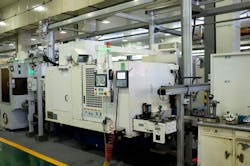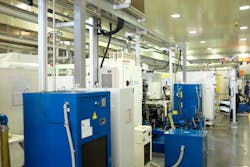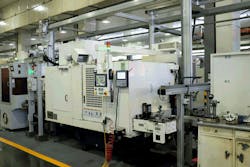AI models and the IIoT close the loop and optimize manufacturing
The technologies in artificial intelligence (AI) and the Industrial Internet of Things (IIoT) are coming together in a testbed to highlight their real value in a variety of manufacturing applications. The Industrial Internet Consortium (IIC) announced the Optimizing Manufacturing Processes by Artificial Intelligence (OMPAI) testbed. The testbed explores the application of AI and IIoT technologies, deployed from the edge to the cloud, to optimize automotive manufacturing processes (Figure 1).
Figure 1: The OMPAI testbed explores AI and IIoT technology at the machine and deployed from the edge to the cloud.
(Source: Thingswise)
“The application of artificial intelligence in manufacturing is a fledgling field of development in much need of demonstrable success or return on investment," says Dr. Shi-Wan Lin, CEO and co-founder of Thingswise, an Industrial Internet platform solution provider and a member of the IIC. "There is also a challenge of bringing the requisite IT/AI and OT expertise together to enable this development. It is exciting to see yet another large global manufacturer taking the lead in an IIC testbed, bringing deep knowledge in production technology to bear, with a focus on applying Industrial Internet technologies and AI to solve core manufacturing problems, extending from traditional predictive maintenance to production-quality and process optimization. I'm confident that this testbed will bring valuable experience and insights to the industrial Internet community.”
IIC testbeds are where the innovation and opportunities of the Industrial Internet happen. IIC member companies partner to create solutions that are not only connected, but also share data. The outcomes from testbeds are the cornerstones of a feedback loop from concept to reality and back to guidance for further innovation.
A model AI testbed
This testbed has just been approved and started for a number of use cases with advanced analytics, including machine learning and other AI operations into manufacturing processes," says Lin. "The use cases have been formed up with factory support, and we are gathering data from production lines. We are also building models and looking at how to deploy assets to collect live data."
A model in the world of AI is mathematical; it's an algorithm that uses statistics to find patterns in data. The patterns are not specifically programmed; they are a possible, hypothetical result expected where the probability of the result can be updated as more historical data and information is available. The end goal of the model and testbed is to learn from the data and apply the lessons learned, real-time, in a close loop fashion to factory operations and processes.
"We separate data into two aspects" says Lin. "There is historic data we can get our hands on as a base, a starting point to build different machine learning models. We then apply the model in the environment—on the plant floor—to close the loop. We are also deploying assets, such as IoT gateways, based on EdgeX, an open-source software framework for IoT edge computing, to collect the live data. The live data is also used in the models and applied, providing feedback to the manufacturing process."
The feedback is used for quality control and process optimization, continues Lin. "It will help improve productivity of the existing assets and with preventive maintenance."
The testbeds
At IIC, the testbed is not just a conceptual idea, it's an actual system that is implemented. "For this OMPAI testbed, the system has been built in Hangzhou, China, where Hangzhou Group is headquartered, one of the largest automotive manufacturers in the world," says Lin. "The Thingswise technology, from the company I co-founded, has been deployed there for a number of months with data being fed to it as part of the testbed (Figure 2)."
Figure 2: The testbed is an actual system that is implemented on assembly lines in Hangzhou, China, at one of the largest automotive manufacturers in the world.
(Source: Industrial Internet Consortium)
Thingswise basically provides a portable, Industrial Internet platform for using advanced analytics and AI to optimize manufacturing processes. "Part of the AI system has been deployed," says Lin. "This includes the lower half of the system; the part that connects to the machines to gather data has been designed and built. It's a real system with the objective to test out the ideas of the testbed with live systems in live factories, not a paper exercise. The testbed systems will be implemented in a few factories in Hangzhou and while it's at an early stage, it will be much more substantial when we have concrete results."
The testbed involves mostly discrete manufacturing, and the idea is simple. "We are collecting data from the machines, and we then apply analytics to the data to provide insight on the product quality, the manufacturing process and the management aspect," says Lin. "The idea is to get insight from the model, whether simple or AI-based, about the products, operations, energy consumption and processes to optimize production—a closed loop. Otherwise, the data is just a nice curve on a graph for human consumption without process benefits."
AI testbed focus
The testbed focuses on connecting to the machine, collecting the data, the model and applying the results back to the process. "Often, the IoT media talks about preventive maintenance," says Lin. "This is a great area of focus, but it is just one of many to ensure quality, production and cost benefits. In a testbed example, the model is used to predict when to replace a grinding wheel on a grinding machine. When is the optimal time to replace the grinding wheel in these precise manufacturing cells? The models can eliminate waste by not replacing the wheels too early but before quality issues occur. It can also determine when to replace the wheel without impacting production."
Another model focuses on the manufacturing space, as the IIoT can go beyond just preventive maintenance. "Quality is one of the three basic elements that manufacturing is seeking along with cost and productivity," says Lin. "Surface quality is important in automotive components, and, while surface defect inspection equipment may be present on the production line, its accuracy is only about 94%. That means 6% actually require manual inspections. This increases cost, and relying on manual inspection is not always the best solution—it's only human to make mistakes. At times it can be unreliable and subjective."
The idea is to determine if we can use machine learning, especially deep learning, to do a better job, explains Lin. "An example would be to take high-speed pictures of an axle surface and apply a deep-learning model to detect defects beyond the current accuracy of 94%," he says. "The goal is 99%, which would be a huge gain in productivity and quality. We hope the machine learning and AI techniques will improve the quality assurance processes (Figure 3)."
Figure 3: Can AI techniques such as deep learning improve inspection accuracy to 99% to improve productivity and quality at the output of CNC grinding equipment?
(Source: Industrial Internet Consortium)
A third testbed is striving to improve the production rate in a high-volume gear production line. "The current production optimization was done by hand calculation to increase the number of parts per minute," says Lin. "However, considering the complexity of the production line, relying on purely hand calculations can only go so far. The idea here is to determine if we can collect enough information from each of our work cells and then use the data to build a model on which we can apply, for example, simulation techniques to find the best configuration of the production line to increase the production rate further."
Spread the AI
"There are a number of test cases across a number of factories and across different parts of the manufacturing environment," says Lin. "The deliverable to the IIC community is our experiences and best practices. In this testbed, not only did we develop a real system, we produced a number of reports and whitepapers and other reports published within the IIC community and some to the public, as well."
AI is being applied into the manufacturing space, and it is focusing on real models and use cases, continues Lin. "Where the model is run—in the cloud or on the edge—is also a consideration," he says. "With high-speed inspection of production, we are exploring where to best deploy the model. In this high-speed use case, system latency, reliability and security are concerns, so AI models will be deployed in multiple places. What algorithms are applicable and where to place the model will be based on the requirements. The model may be built in the cloud but may need to be run closer to the edge or at the edge."
The gateways will be collecting the data, but they will potentially be running the model. Dell EMC is a partner. It has much to contribute on the edge computing side, as well as the EdgeX platform. There is great potential.
ALSO READ: Get control of maintenance
About the Author

Dave Perkon
Technical Editor
Dave Perkon is contributing editor for Control Design. He has engineered and managed automation projects for Fortune 500 companies in the medical, automotive, semiconductor, defense and solar industries.

Leaders relevant to this article:




